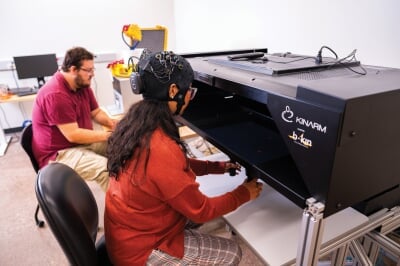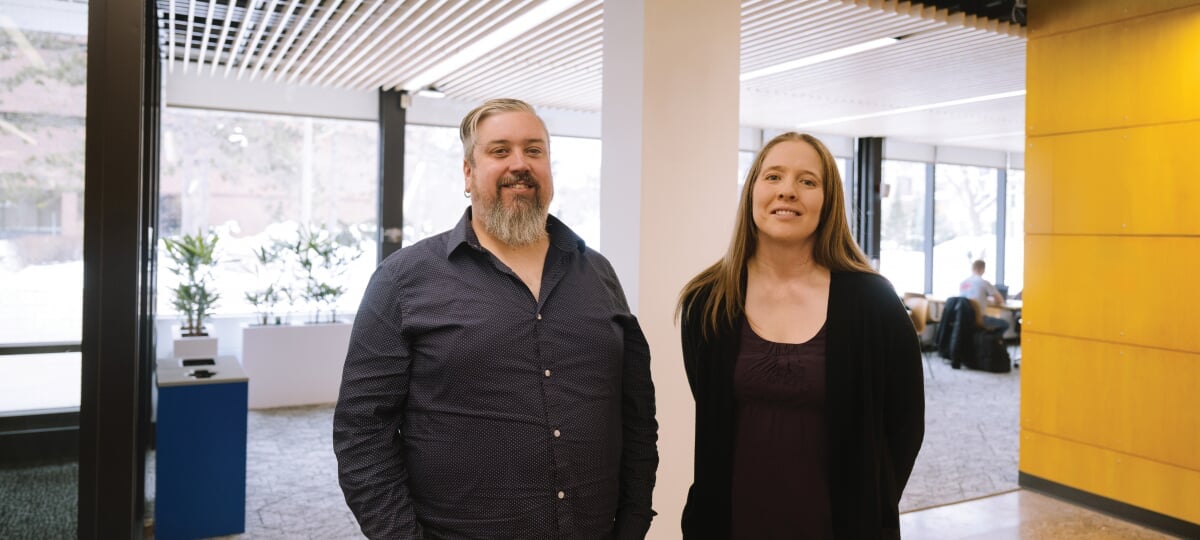From slip-and-falls to the subtlest of motor movements, Tech researchers are exploring the brain-body connections behind aging independently and well.
Though their work takes place in different labs in Michigan Tech's H-STEM Engineering and Health Technologies Complex, Michigan Tech researchers Kevin Trewartha and Carolyn Duncan share a common mission: helping people live longer, better, and on their own terms. Both are interested in how we sense our surroundings—and what that means for the freedom to choose where we live and what we do late into life.
Trewartha, a neuroscientist whose expertise is grounded in psychology and human factors, integrates movement science into his research, which focuses on advancing the ability to detect the preclinical stages of neurodegenerative diseases like Alzheimer's. "The idea is to maximize the benefits of emerging pharmaceutical interventions by being able to identify the condition earlier," he says.
In Duncan's Functional Mobility and Human Biomechanics Lab, researchers examine the factors that affect our ability to regain balance when we lose it. Her team also develops effective outreach strategies to help prevent falls. "I joke that I make people fall for science," says Duncan, an engineer with industry experience in ergonomics and fall prevention.
There's more at stake in their research than individual quality of life, says Trewartha. "Making sure people stay healthy for as long as they can eases the burden on families and caregivers and reduces healthcare costs. It's a societal snowball effect that reduces the burden on the entire system."

Aging and Cognition
Cracking the Cognitive Code
One of the biggest challenges in aging research is distinguishing between people who are going through normal age-related changes in cognitive function and those who are experiencing more serious cognitive decline. There's currently no definitive way to determine the initial onset of neurodegenerative conditions like Alzheimer's disease.
There are, however, strong links between cognitive function and subtle motor movement—maybe stronger than previously thought.
"Historically, neuroscience tended to just focus on highly cognitive tasks. Motor behaviors were largely ignored," says Trewartha, whose Aging, Cognition, and Action Lab is a hub for researchers from both the College of Computing and the College of Sciences and Arts. "Now folks are starting to think a lot more about even simple motor behaviors like balance, posture, and gait as a rich source of information."

Trewartha is currently wrapping up work funded through a $554,124 National Institutes of Health grant that compares people diagnosed with mild cognitive impairment or with early Alzheimer's disease to people who don't have either condition. The end goal is to develop a motor learning task that could be adapted for use in a clinical setting as a diagnostic tool.
One of the primary tools the lab uses for data collection is electroencephalography (EEG), which measures electrical activity from the brain. Study participants complete various movements—using levers that require them to extend and bend their arms to move a cursor on a screen—while wearing an electrode cap that measures the electrical activity of the population of neurons in their brains. Safe and non-invasive for participants, its precise temporal scale reveals millisecond-to-millisecond changes in different areas of the brain. Researchers examine how participants adapt their arm movements through trial-and-error in the activity, which includes adding force so participants have to push back against the levers to move them.
Trewartha's future research will harness the power of data science and artificial intelligence models, he says, tying in behavioral data with bio- and genetic markers in hopes of further improving the predictive ability of tests to detect neurodegenerative conditions and their trajectory.
The promise of improved diagnostic testing offers hope to those looking to improve their chances of aging in place and avoiding life-changing injuries—as do other solutions being discovered even closer to home.
Fall-proofing Built Environments
In the United States, a person 65 or older falls every second. Simple changes in our homes—high-contrast stairsteps, well-lit rooms, the elimination of throw rugs—can add years to our lives, says Duncan. In her lab, she works toward reducing the incidence of falls on a larger scale.
"We have ways to keep people in their houses longer, and we do that by focusing on functional mobility and the activities of daily life, like walking on stairs and ramps," says Duncan. "When you limit mobility you are limiting independence, and when you take away someone's independence, that's when quality of life and mental health disappears, too. I tend to focus on environmental factors because I come from an ergonomics background and because—as we all know—it's a lot easier to change the environment than it is to change a person."
But in rural areas like the Keweenaw, which have aging populations and aging housing stocks, readily available resources for such change are not a given. "We want non-invasive technologies that we can use in challenging rural environments where we have less access to healthcare and practitioners," says Duncan. "We need affordable options for people with less access to resources."
"It makes so much sense for Michigan Tech to keep pushing health research forward and delivering these amazing clinical programs and health programs. Our research reflects the needs of the community. It's serving the people here."
Duncan's research, which encompasses older adults and special populations, has been funded through Blue Cross Blue Shield and the Portage Health Foundation, now known as Copper Shores Community Health Foundation. Her work includes fall-scenario simulation, using protective harnesses and eye tracking technology to examine where people are looking in areas with diminished lighting before and when they lose their balance.
This science is then coupled with outreach activities to raise awareness and inspire action on a community level—putting Duncan at the forefront of the joint effort to make homes safer and to find effective ways to connect healthcare networks in rural communities.
Like Trewartha, Duncan relies on members of the local community who are willing to participate in her research, not for personal gain but because they recognize that she and her fellow researchers want to help society. In a country where more than one in four people age 65 and older fall every year, the importance of Duncan's research is hard to overstate.
"Human-centered research is community-driven," says Duncan. "I want my research to reflect that Michigan Tech is an integral part of the community."
A New Home in H-STEM
Duncan and Trewartha both agree that the H-STEM Complex, which officially opened in spring 2024, is raising awareness of health research at Michigan Tech and increasing collaborative opportunities. For example, projects on Duncan's horizon include obstacle avoidance studies with Trewartha and Kelly Steelman, chair of the Department of Psychology and Human Factors and an expert in gaze behavior research.

"Everybody works together here, and you get these amazing collaborations out of it," Duncan says. "And we're not just collaborating, but really creating community. It's not always easy. Sometimes you're wracking your brain, but when you have such a community that's so connected, it makes the link."
Trewartha agrees, saying breakthroughs are coming via collective efforts on campus. "It's not one person working in their lab and independently coming up with some cool discovery. It's the exponential power of collaborative science at work," he says. "You can't be the expert in everything. So in H-STEM, we're thinking about the pieces we each can offer and how our research dovetails with somebody else's. That is where innovation comes from—from multiple people bringing their expertise in different perspectives toward solving an individual problem."
Michigan Technological University is an R1 public research university founded in 1885 in Houghton, and is home to nearly 7,500 students from more than 60 countries around the world. Consistently ranked among the best universities in the country for return on investment, Michigan's flagship technological university offers more than 120 undergraduate and graduate degree programs in science and technology, engineering, computing, forestry, business, health professions, humanities, mathematics, social sciences, and the arts. The rural campus is situated just miles from Lake Superior in Michigan's Upper Peninsula, offering year-round opportunities for outdoor adventure.




